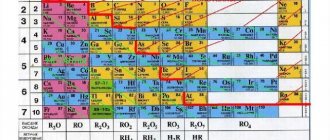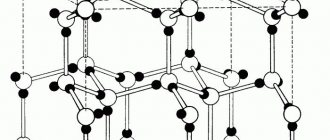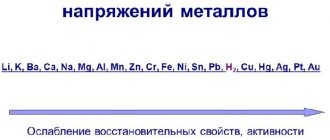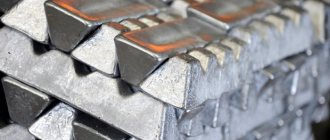Position in the periodic table
The metallic properties of elements decrease from left to right in the periodic table. Therefore, elements of groups I and II are considered the most active.
Rice. 1. Active metals in the periodic table.
All metals are reducing agents and easily part with electrons at the outer energy level. Active metals have only one or two valence electrons. In this case, metallic properties increase from top to bottom with increasing number of energy levels, because The further an electron is from the nucleus of an atom, the easier it is for it to separate.
Alkali metals are considered the most active:
- lithium;
- sodium;
- potassium;
- rubidium;
- cesium;
- French
Alkaline earth metals include:
- beryllium;
- magnesium;
- calcium;
- strontium;
- barium;
- radium.
The degree of activity of a metal can be determined by the electrochemical series of metal voltages. The further to the left of hydrogen an element is located, the more active it is. Metals to the right of hydrogen are inactive and can only react with concentrated acids.
Rice. 2. Electrochemical series of voltages of metals.
The list of active metals in chemistry also includes aluminum, located in group III and to the left of hydrogen. However, aluminum is on the border of active and intermediately active metals and does not react with some substances under normal conditions.
History of discovery
Its discovery belongs to the German researchers R. Bunsen and G. Kirchhoff. Even then, scientists were interested in which metals were active and which were not. In 1860, researchers studied the composition of water from the Durkheim Reservoir. They did this using spectral analysis. In the water sample, scientists found elements such as strontium, magnesium, lithium, and calcium.
They then decided to analyze the drop of water using a spectroscope. That's when they saw two bright blue lines located not far from each other. One of them, in its position, practically coincided with the line of the metal strontium. Scientists decided that the substance they identified was unknown and classified it as an alkali metal.
In the same year, Bunsen wrote a letter to his photochemist colleague G. Roscoe, in which he talked about this discovery. Cesium was officially reported on May 10, 1860 at a meeting of scientists at the Berlin Academy. After six months, Bunsen was able to isolate about 50 grams of cesium chloroplatinite. Scientists processed 300 tons of mineral water and isolated about 1 kg of lithium chloride as a byproduct to ultimately obtain the most active metal. This suggests that mineral waters contain very little cesium.
The difficulty of obtaining cesium constantly pushes scientists to search for minerals containing it, one of which is pollucite. But the extraction of cesium from ores is always incomplete; during operation, cesium dissipates very quickly. This makes it one of the most difficult to obtain substances in metallurgy. The earth's crust, for example, contains 3.7 grams of cesium per ton. And in one liter of sea water, only 0.5 μg of the substance represents the most active metal. This makes cesium extraction one of the most labor-intensive processes.
Properties
Active metals are soft (can be cut with a knife), light, and have a low melting point.
The main chemical properties of metals are presented in the table.
| Reaction | The equation | Exception |
| Alkali metals spontaneously ignite in air when interacting with oxygen | K + O2 → KO2 | Lithium reacts with oxygen only at high temperatures |
| Alkaline earth metals and aluminum form oxide films in air and spontaneously ignite when heated | 2Ca + O2 → 2CaO | |
| React with simple substances to form salts | – Ca + Br2 → CaBr2; – 2Al + 3S → Al2S3 | Aluminum does not react with hydrogen |
| React violently with water, forming alkalis and hydrogen | – 2Na + 2H2O → 2NaOH + H2; – Ca + 2H2O → Ca(OH)2 + H2 | The reaction with lithium is slow. Aluminum reacts with water only after removing the oxide film |
| React with acids to form salts | – Ca + 2HCl → CaCl2 + H2; – 2K + 2HMnO4 → 2KMnO4 + H2 | |
| Interact with salt solutions, first reacting with water and then with salt | 2Na + CuCl2 + 2H2O: – 2Na + 2H2O → 2NaOH + H2; – 2NaOH + CuCl2 → Cu(OH)2↓ + 2NaCl |
Active metals easily react, so in nature they are found only in mixtures - minerals, rocks.
Rice. 3. Minerals and pure metals.
Receipt in Russia
As stated, the main mineral from which cesium is obtained is pollucite. This most active metal can also be obtained from rare avogadrite. Pollucite is used in industry. It was not mined in Russia after the collapse of the Soviet Union, despite the fact that even in those days gigantic reserves of cesium were discovered in the Voronya tundra near Murmansk.
By the time the domestic industry could afford the extraction of cesium, the license to develop this deposit was acquired by a company from Canada. Now cesium extraction is carried out by Novosibirsk.
What have we learned?
Active metals include elements of groups I and II - alkali and alkaline earth metals, as well as aluminum. Their activity is determined by the structure of the atom - a few electrons are easily separated from the external energy level. These are soft light metals that quickly react with simple and complex substances, forming oxides, hydroxides, and salts. Aluminum is closer to hydrogen and its reaction with substances requires additional conditions - high temperatures, destruction of the oxide film.
How was cesium discovered?
The most active metal was the first chemical element, the presence of which in the surface of the earth's crust was discovered using the method of spectral analysis. When scientists received the spectrum of the metal, they saw two sky-blue lines in it. This is how this element got its name. The word caesius translated from Latin means “sky blue”.
Properties and characteristics of lithium metal
Lithium metal has unique chemical and physical properties. It differs from other alkali metals, which expands its application possibilities in various fields of activity. It is very important for the proper functioning of the body.
Chemical element lithium
Short description
Lithium is an alkali metal that has pronounced plastic properties, a silvery color, and a characteristic metallic luster. It is easy to process and has a low melting point of 180°C. When compared to other alkali metals, it has the lowest density. Since it is lower than that of water, the material floats to the surface.
Structure and characteristics
The crystal lattice structure of metallic lithium is cubic, body-centered. Its parameters are 3.490 Å. These characteristics are observed only at room temperature.
The lithium atom has two shells - outer and inner. The outer one contains electrons. They participate in the formation of chemical bonds.
History of discovery and study
The first sample of lithium metal was obtained thanks to the work of Humphry Davy. Using an electric current, he decomposed the molten hydroxide of this alkali metal. After some time, Leopold Gmelin experimented with lithium-containing salts. He was able to detect that they paint the flames a dark color.
The main credit for the discovery of a new chemical element and the growth of its popularity belongs to Johann August. In 1817, he discovered a new substance in petalite, an aluminosilicate. After some time, lithium was found in other mineral formations. It received this name due to the fact that it was first found in stones. The name of the stone in Greek is “lithos”.
Petalite (Instagram / lopatkin_oleg)
Deposits and production
Lithium is found in various minerals. The richest stones in terms of the content of this alkali metal are mica lepidolite and pyroxene spodumene. Lithium can be found in various rock-forming minerals. In them it replaces calcium.
Uses of cesium
This metal is used to make various solar cells. Cesium compounds are also used in special branches of optics - in the manufacture of infrared devices and night vision binoculars. Cesium is used in the manufacture of sights that allow you to notice enemy equipment and manpower. It is also used for the manufacture of special metal halide lamps.
But this does not exhaust the range of its application. A number of medical preparations have also been created based on cesium. These are medications for the treatment of diphtheria, peptic ulcers, shock and schizophrenia. Like lithium salts, cesium salts have normothimic properties - or, simply, they are able to stabilize the emotional background.
Francium metal
Another of the metals with the most intense properties is francium. It got its name in honor of the homeland of the discoverer of metal. M. Peret, born in France, discovered a new chemical element in 1939. It is one of those elements about which even chemist researchers themselves find it difficult to draw any conclusions.
Francium is the heaviest metal. Moreover, the most active metal is francium, along with cesium. Francium has this rare combination of high chemical activity and low nuclear resistance. Its longest-lived isotope has a half-life of only 22 minutes. Francium is used to detect another element, sea anemone. Francium salts were also previously proposed to be used to detect cancer tumors. However, due to its high cost, this salt is not profitable to produce.
Properties of alkaline earth metals
Alkaline earth metals are much harder than alkali metals and cannot simply be cut with a knife. They are also heavier - their density ranges from 1550 kg/m3 for calcium to 5500 kg/m3 for radium. The color of alkaline earth metals is gray. The melting points of these elements are in the range of 650-840°C. The exception is beryllium, which melts only at 1278°C.
The higher the atomic number of an alkaline earth metal in the periodic table, the higher its chemical activity. For example, beryllium does not interact with oxygen at all and its properties resemble aluminum. The most active strontium, barium and radium must be stored in kerosene, as well as alkali metals.
Comparison of the most active metals
Ununennium is a metal that has not yet been discovered. It will occupy first place in the eighth row of the periodic table. The development and research of this element is carried out in Russia at the Joint Institute for Nuclear Research. This metal will also have to have very high activity. If we compare the already known francium and cesium, then francium will have the highest ionization potential - 380 kJ/mol.
For cesium this figure is 375 kJ/mol. But francium still does not react as quickly as cesium. Thus, cesium is the most active metal. This is an answer (chemistry is most often the subject in whose curriculum you can find a similar question), which can be useful both in a lesson at school and in a vocational school.







